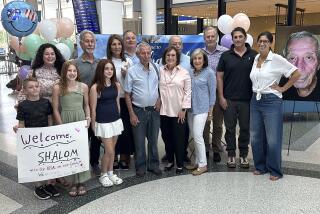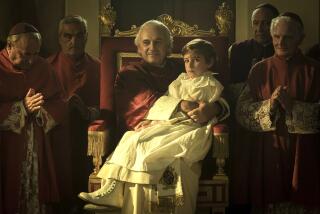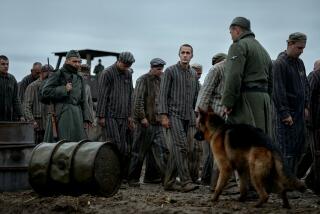Heroism in a time of evil
- Share via
Aviva Slesin is wrestling with a “profound mystery,” perhaps one of the most enigmatic of the Holocaust. Not the evil of the perpetrators or the fate of the victims, but the sublime courage and humanity of the rescuers.
Why did thousands upon thousands of Gentile families hide Jewish children, mostly complete strangers, during the Nazi occupation of their countries, knowing full well that they and their kin would likely be shot if caught?
Slesin is the producer-director of “Secret Lives: Hidden Children & Their Rescuers During World War II,” opening Friday in Los Angeles. The veteran filmmaker won a 1987 Oscar for her feature documentary “The Ten-Year Lunch: The Wit and Legend of the Algonquin Round Table.” After tracking down and interviewing 10 former hidden children and their rescuers some 55 years after the war, Slesin still doesn’t know the answer to the question.
In her own case, Slesin was sedated and smuggled out of a Lithuanian ghetto when she was 9 months old and sheltered by a Christian family for 2 1/2 years.
When she returned in 1994 and asked her own Lithuanian “mother” why she protected her in a country in which most of the local population enthusiastically participated in the murder of 98% of its Jews, the old lady just sighed and appeared puzzled by the very question.
Slesin and her story are not shown in the film, but she recalls the belated reunion in a phone call from her New York apartment.
“I didn’t recognize my rescue mother and remembered nothing of my time in hiding, but the feeling between us was so powerful that I decided to find other hidden children and make this film,” she says.
The Hidden Child Foundation/Anti-Defamation League in New York, which has 5,000 members across the world, including a couple of hundred in Los Angeles, gives a rough estimate that the number of Jewish children sheltered by non-Jews during the war ran into the “tens of thousands.” Slesin and her co-producer and writer, Toby Appleton Perl, selected a sampling of 10 surviving ex-children and their rescuers, and for three years traveled to Poland, Holland, Belgium, France and Israel to record their stories.
“There were a number of families which hid kids because they were paid for it, to convert them or to exploit them for cheap labor. We eliminated all of those,” Slesin says.
The winnowed group of rescuers, individually and collectively, constitutes a profile in instinctive civil courage that puts to shame our promiscuous use of the word “hero.” Nowhere was courage and compassion required more than in Poland, where neighbors, frequently anti-Semitic or fearing punishment if they didn’t inform the Germans, were a constant danger.
One Polish rescuer, Genowefa Nowak, recalls matter-of-factly that “if they had caught us, first they would have shot my children right before my eyes, then the child we were hiding, and then they would have killed us. But we didn’t think about the danger. We just wanted to save the child.”
The child was Ephraim Gat, then 5, who spent two years crammed into a small closet. “I was never sick, I never coughed, never sneezed. I was so quiet, no one knew I was there,” he remembers half a century later, as he revisits his solitary confinement.
Even if the rescuers did not try to convert their Jewish wards, for sheer self-protection the hidden children had to take on the lifestyle and churchgoing habits of their new families.
“I came to believe that my parents were killed because they were Jews and I was saved because I was a Catholic,” recalls one girl, who years later reclaimed her Judaism and emigrated to Israel.
Most of the children and their new parents came to love each other, but the normal strains of family life, exacerbated by the constant danger and secrecy, led to some still-remembered conflicts and resentments.
Hetty Vos-Crews, a young girl when her Dutch family took in Moana Hilfman, says she has never forgiven her parents for risking the family’s lives to hide a Jew. At the same time, Vos-Crews denounces the court that awarded Molana to her returning biological parents after the war.
Slesin is not surprised by the apparent emotional contradiction. “I can understand that a Dutch girl could both resent and love a sudden newcomer,” she says. “It just proves that people are complicated.”
Most hidden children lost their birth parents in the Holocaust. Slesin’s mother, the family’s only other survivor, had contracted typhoid fever in a concentration camp and forgotten who had sheltered her child.
For six months after liberation, the mother searched for her daughter, and when she found her, 3-year-old Aviva at first refused to go with the sickly looking stranger.
The rescuers came from all backgrounds, and scholars have not been able to identify a common characteristic. They were rich and poor, socialists and conservatives, peasants and intellectuals, devout Christians and atheists. When asked, just about all of them reply that they did nothing extraordinary.
“I still don’t understand why they did it, and that continues to be a profound mystery to me,” Slesin says. “And then you ask yourself, ‘What would I have done in the same situation?’ That remains a haunting question.”
More to Read
Only good movies
Get the Indie Focus newsletter, Mark Olsen's weekly guide to the world of cinema.
You may occasionally receive promotional content from the Los Angeles Times.










